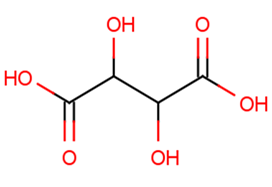
D(-)-Tartaric acid
CAS No. 526-83-0
D(-)-Tartaric acid( —— )
Catalog No. M20459 CAS No. 526-83-0
D(-)-Tartaric acid found in many plants particularly tamarinds and grapesit?is used to generate carbon dioxide through interaction with sodium bicarbonate following oral administration.?
Purity : >98% (HPLC)
 COA
COA
 Datasheet
Datasheet
 HNMR
HNMR
 HPLC
HPLC
 MSDS
MSDS
 Handing Instructions
Handing Instructions
| Size | Price / USD | Stock | Quantity |
| 50MG | 45 | In Stock |


|
| 100MG | Get Quote | In Stock |


|
| 200MG | Get Quote | In Stock |


|
| 500MG | Get Quote | In Stock |


|
| 1G | Get Quote | In Stock |


|
Biological Information
-
Product NameD(-)-Tartaric acid
-
NoteResearch use only, not for human use.
-
Brief DescriptionD(-)-Tartaric acid found in many plants particularly tamarinds and grapesit?is used to generate carbon dioxide through interaction with sodium bicarbonate following oral administration.?
-
DescriptionD(-)-Tartaric acid found in many plants particularly tamarinds and grapesit?is used to generate carbon dioxide through interaction with sodium bicarbonate following oral administration.?Carbon dioxide extends the stomach and provides a negative contrast medium during double contrast radiography.
-
In Vitro——
-
In Vivo——
-
Synonyms——
-
PathwayOthers
-
TargetOther Targets
-
RecptorOthers
-
Research Area——
-
Indication——
Chemical Information
-
CAS Number526-83-0
-
Formula Weight150.09
-
Molecular FormulaC4H6O6
-
Purity>98% (HPLC)
-
Solubility——
-
SMILESOC(C(O)C(O)=O)C(O)=O
-
Chemical Name——
Shipping & Storage Information
-
Storage(-20℃)
-
ShippingWith Ice Pack
-
Stability≥ 2 years
Reference
1.Danilewicz John C . Role of Tartaric and Malic Acids in Wine Oxidation[J]. Journal of Agricultural and Food Chemistry 2014 62(22):5149-5155.
molnova catalog



related products
-
2'-Deoxycytidine 5'-...
2'-Deoxycytidine 5'-monophosphate (dCMP) is used as a substrate of uridine monophosphate (UMP)/cytidine monophosphate (CMP) kinase (EC 2.7.4.4) to form dCDP which upon phosphorylation to dCTP supports DNA biosynthesis.
-
Aminacrine
9-Aminoacridine is a highly fluorescent dye used clinically as a topical antiseptic and experimentally as a mutagen, an intracellular pH indicator.
-
DSP-4 hydrochloride
DSP-4 hydrochloride (Neurotoxin DSP 4 hydrochloride) can be used for the temporary selective degradation of the central and peripheral noradrenergic neurons, mainly those from the locus coeruleus (LC).



 Cart
Cart
 sales@molnova.com
sales@molnova.com


